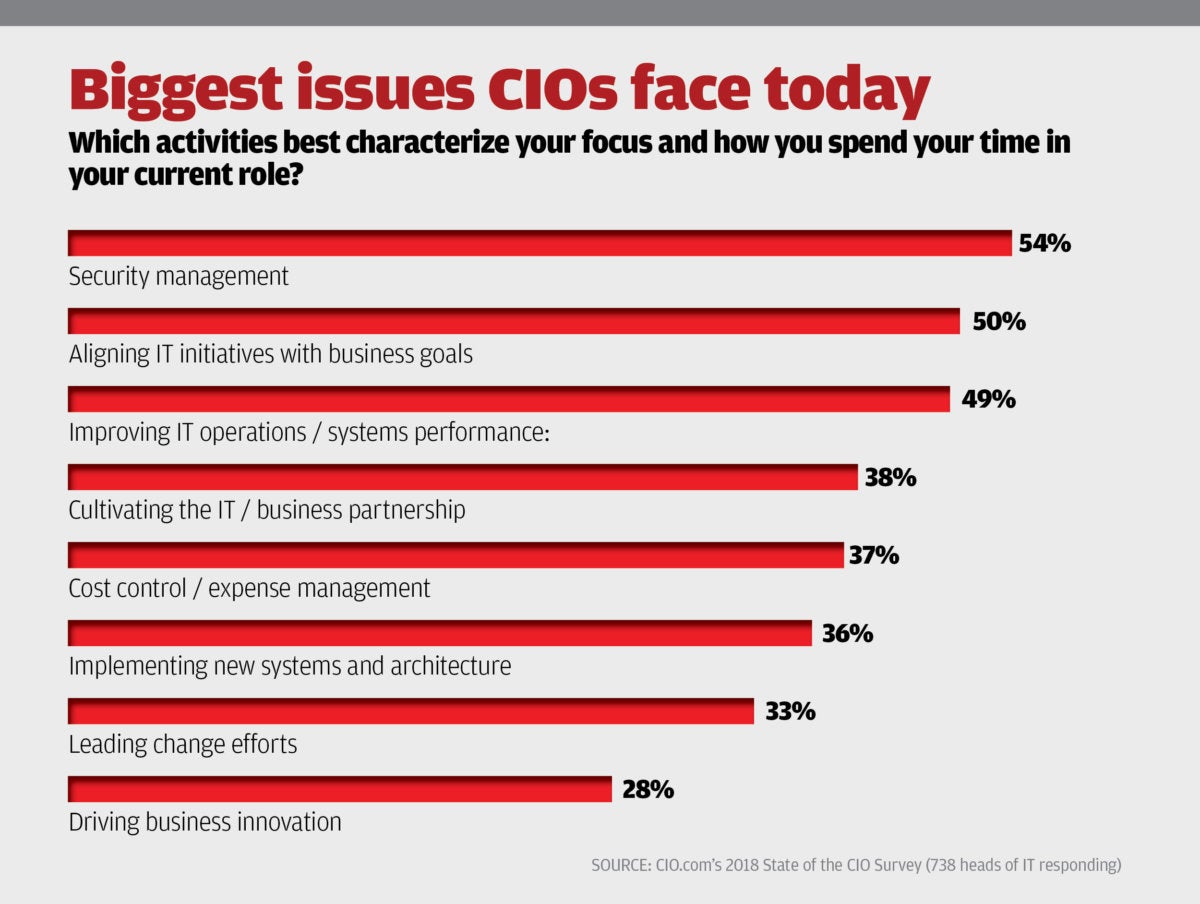The biggest Issues CIO’s face today.
From security management to seeking out innovative technologies, CIOs are straddling operational and transformational roles to deliver new wins while keeping IT humming.
“I really do try to stay in the strategic,” she says. “I have the direct report staff that really handles most of the operations, but the IT buck stops with me. I want to make sure that we’re pushing efficiencies and utilizing our resources in the best way that we can.”
Workman isn’t alone. The majority of IT leaders today are caught in a balancing act, having to split time between transformational leadership and innovation, and the functional requirements that characterize the traditional CIO role. In fact, despite the increasing drumbeat for digital transformation, 87 percent of respondents to the 2018 State of the CIO survey said they are still juggling standard IT operational tasks.
The gravitational pull of security issues, budget battles, and system and architecture headaches can tug IT leaders away from projects that can move the organization forward, but CIOs are finding ways to address the operational challenges that are pulling their focus, and re-centering on the transformational.
Here are the five most pressing issues that CIOs are facing today — and how several IT executives are tackling them.
Security management
More than half of CIOs point to security management as a major focus of their time. “It’s a constant, unrelenting battle,” says Don Naglich, director of IT at Franciscan Ministries, operators of 10 continuing care retirement communities and ancillary facilities in four states that serve about 2,000 residents.
Naglich can spend up to 25 percent of his day assessing the security posture of systems at the Lemont, Ill.-based care provider to make sure he’s protecting patient information and complying with HIPAA regulations.
Threats now come from the most unlikely places. “We found one vendor’s IoT devices that they used in our communities trying to contact foreign entities,” Naglich says. Wireless emergency call system devices, which residents can trigger with pull-chains in their rooms or on wearable call buttons, were trying to exit the network with information. “Our firewall was blocking them, but the devices were being very insistent. They were putting down parts of the wireless network by flooding the network with request packets,” he says.
IDG
Today all third-party products and IoT-connected devices at Franciscan Ministries have been moved off of production servers and onto their own server. The firewall now blocks all traffic coming from 120 countries where the organization doesn’t do business. Naglich has also moved from signature-based antivirus software, which typically identifies known malware, to behavior-based antivirus that evaluates an object based on its intended or potential actions before it can execute that behavior. “You have to pay attention to every single thing,” Naglich says. He’s now focused on bringing artificial intelligence and voice-activated features to the retirement communities.
Aligning IT initiatives with business goals
Half of CIOs in the State of the CIO survey say that the bulk of their time is spend aligning IT initiatives with business goals.
At Case Western Reserve University in Cleveland, Workman is constantly working on how to optimize technology to help staff teach, students learn, researchers discover and administrators perform efficiently at the university.
“One of the biggest things for CIOs, especially in the research university world, is that you are part of everything that happens,” says Workman.
Among Workman’s major projects, applying cutting-edge technology to a new, almost 500,000-square-foot health education campus, a partnership with the Cleveland Clinic that will integrate the schools of medicine, nursing, dental medicine and the Cleveland Clinic Lerner College of Medicine, a program within the university’s medical school.
Starting in the fall 2019, anatomy classes on the new campus will be taught using holograms, replacing most of the traditional cadavers. The university is Microsoft’s first education partner to implement its HoloLens head-mounted displays. “We’ve had to learn how do we deliver wireless networks to a room with possibly 100 hologram headsets in them. It takes time to learn how to support them, too. How do you charge and clean them? But we’ve worked through all of that now,” Workman says.
Students also demand the latest technology, and Workman tries to stay ahead of the latest trends to keep the university competitive with prospective students.
“Eighth graders today have Alexa and Siri. All they have to do is ask a question. So we’re starting to work on some prototypes,” such as a chatbot that will allow students to ask verbal questions like, ‘Where’s the bus?’ or ‘What restaurants take my food card?’
“The CIO of today is a tech innovator and not necessarily a techie,” Workman says. “I really think that university IT organizations have to be much more agile and innovative. Yes, we still have to do ERP and LMS, but also have some resource carved out to really have fun and experiment.”
Improving systems performance and controlling costs
Nearly half of CIOs (49%) say they’re focused on improving systems performance, and 37 percent spend a portion of their time controlling costs. American International College in Springfield, Mass., has grappled with shrinking IT budgets for two years as the university, like many others, holds or lowers tuition costs at the expense of institutional spending.
“We’re very financially disciplined, so I need to [make technology decisions] for the right reasons and make sure it has good ROI,” says CIO Mimi Royston.
To squeeze the most out of its systems, the IT department is going through a business process review of all 41 major software systems to see how they can improve the automation within each product, and to integrate data flow between systems to operate with fewer silos.
“That has really helped with business process improvements as far as flow of data, communication and work processes that often get stuck somewhere. We can now automate that data flow,” Royston says.
This summer the university will implement six new software packages that all require integration with at least one other system. For instance, “Our athletic office software helps with compliance and tracking of recruiting and the regulations/requirements around recruiting. We’re bringing in data from the registrar, student accounts, financial aid and admissions” using Microsoft SQL server integration services, Royston says.
“We’re always managing growth through austerity,” she adds. “To do that you need to make good decisions, and you need data flow to make those good decisions.”
Implementing new systems and architecture
A third of CIOs spend the bulk of their time implementing new systems and architecture to support the business.
Data is the lifeblood of Emerald Expositions Events in Orange County, Calif., which operates more than 55 business-to-business tradeshows in the U.S. with 500,000 global attendees and exhibitors. “We live and breathe on the data we have on our customers and show attendance,” says CIO Bill Charles.
Charles has spent much of his time implementing an Informatica cloud solution to help with data management between systems, and Tableau to make it easier for business units to have access to the data they need without IT’s help. “We want to empower them to run their own reports, give them data and use that to drive decisions,” he says.
The biggest challenge for Charles is keeping up with the in-house skill sets that are needed to support all the new and fast-changing technology.
“We outsource all development to third-party vendors and most of the support is done in-house” by a 15-person IT team, Charles says. But with a growing list of new vendor partners, it’s hard to keep the team up to speed. “That knowledge transfer to the support team is difficult to make happen.”
Still, he doesn’t think his challenges are unique. “I think we [CIOs] are all in the same boat — always underfunded, understaffed and too many projects.” But with the new data tools, along with Salesforce, “we’re doing a much better job at closing sales leads,” Charles says.
Leading change efforts and driving innovation
On the digital transformation front, CIOs are playing a significant role assisting the business in driving innovation. Some 88 percent of IT leaders see the CIO role becoming more digital- and innovation-focused, when they can find the time.
A third of CIOs say they’re actively involved in leading change efforts. TGI Fridays CIO Sherif Mityas is one of them. Two years ago, Mityas began re-visioning IT at the casual dining chain “to be where our guests are, and engage and connect with them through the use of technology.” Mityas created a digital platform where customer can interact with the chain both outside the restaurants, through social media and chatbots, and inside with bar-top tablets and personalized TV services. He uses technology from unique vendors such as Amperity, Conversable and Urban Airship. The move has quickly yielded direct ROI. Off-premises orders doubled in the first year, he says.
Now Mityas is taking the tools he has put in place and making them smarter with artificial intelligence. “Now that I’m connected with that guest through a chatbot or digital platform, it’s being able to understand who that person is and create a more direct and personalized connection to one individual guest,” Mityas says. “We can really create and engage on a one-on-one basis and do it at scale with the use of AI.”
Inside the restaurants, AI acts as a kind of digital assistant to general managers on their phone or iPad, he says. “The AI tool learns how that individual store is supposed to operate based on their traffic patterns and staff. They help the GM make decisions around inventory, ordering, labor scheduling, if there’s fraud potentially happening. It’s allowing them to make better, smarter, faster decisions — and to have more time to focus on their guests.” Startup HyperGiant powers some of these in-restaurant AI efforts, he says.
Mityas finds these hot technology prospects by hosting quarterly shark-tank-like competitions where five to six startups give 20-minute pitches. “That’s where we get some of our best ideas. It also allows us to do something that nobody else is doing, at least for a short period of time.” While it’s easy to get caught up in the cool technology, Mityas always reverts back to potential ROI. “Is it right for our guest? Can we execute this? Can we make money off of it? If yes isn’t the answer to all three questions, then it’s not right for the company,” he says.
When it comes to AI, start small, he adds. “These things can get complex and expensive really quickly, so pick one small use case that you know can move the needle, and start there.”




